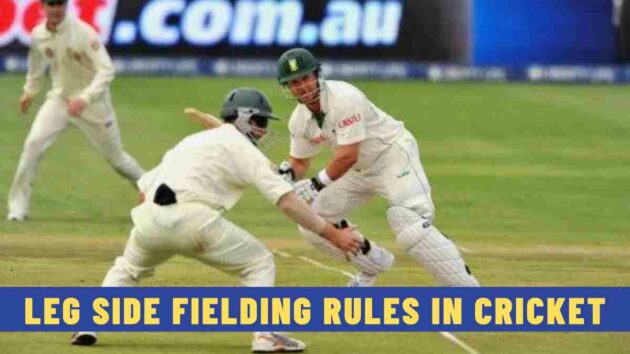As you know, a cricket ground is either an oval-shaped or circular-shaped field. And the ground is virtually divided into 2 halves — off side and leg side — for a better understanding of the match proceedings.
Based on those 2 sides, we can identify shots played by batters and the field placement of a fielder. Speaking of fielding, there are some rules you need to know, especially about fielding on the leg side.
So, let’s delve into the leg side fielding rules in cricket.
Table of Contents
Where is the leg side on the cricket ground?
Before we look at the leg side fielding rules, let’s understand which side of the ground is the leg side. The leg side is also known as the on side.
For a right-hand batter, the leg side region lies on the left while standing in the crease facing the bowler. Whereas, for a left-hand batter, it’s the exact opposite, with the region on their right being the on side.
Now, let’s head over to the rules about leg side fielding.
What are leg side fielding rules?
Unlike fielding on the off side, there are a few restrictions that every team needs to follow.
What restrictions?
1. Only 2 Fielders Behind Square Leg
According to the MCC Laws of Cricket (Law 28.4), the fielding team can only place 2 fielders, except the wicket-keeper, behind the popping crease on the leg side. This rule is applicable in all formats of the game.
2. Maximum 5 Fielders on Leg Side
Moreover, in limited-overs cricket, the fielding side can’t station more than 5 fielders on the on side. So, if a team puts 2 fielders behind the square leg, then only 3 fielders can be placed in front of the square, totalling 5 players.
What if a team breaches the rules?
If the umpires come across any breach of the above 2 restrictions when the ball comes into play, then they will signal it as a no-ball.
Why are these restrictions in place?
The leg side fielding restrictions have been in place for more than 90 years. During England’s tour of Australia in 1932-33, the visitors used controversial ‘bodyline’ tactics to restrict Australian batters from scoring runs and dismissing them.
In this tactic, the England bowlers bowled short-pitched deliveries, with heavy close-leg side fielding aimed at catching the ball. Many Australian batters endured deadly blows on their hands, chests, and heads. At that time, the England team received a lot of flak for using this unfair tactic.
In the summer of 1933, the West Indies team also used the bodyline tactic during their tour of England. Then, the Marylebone Cricket Club (MCC), which maintains cricket laws, introduced the leg side fielding restrictions, negating the unfair practices used by teams.
Read Next | West Indies Cricket: A Tale of Glory and Decline











